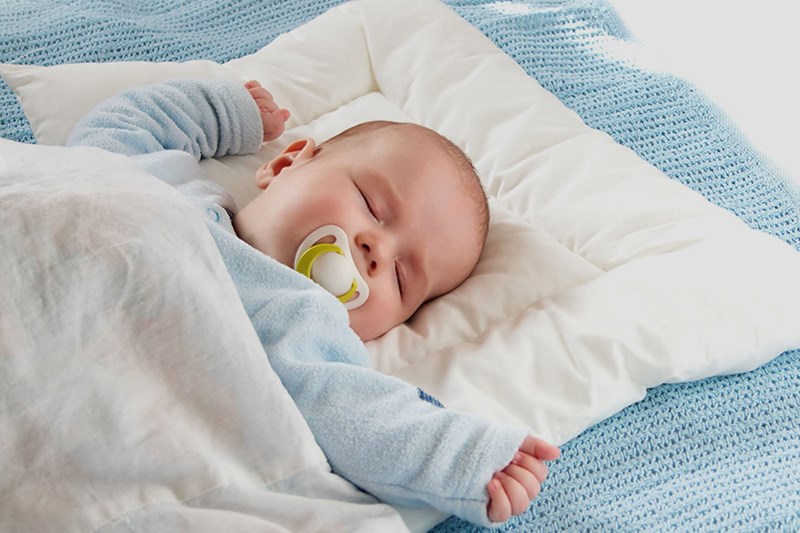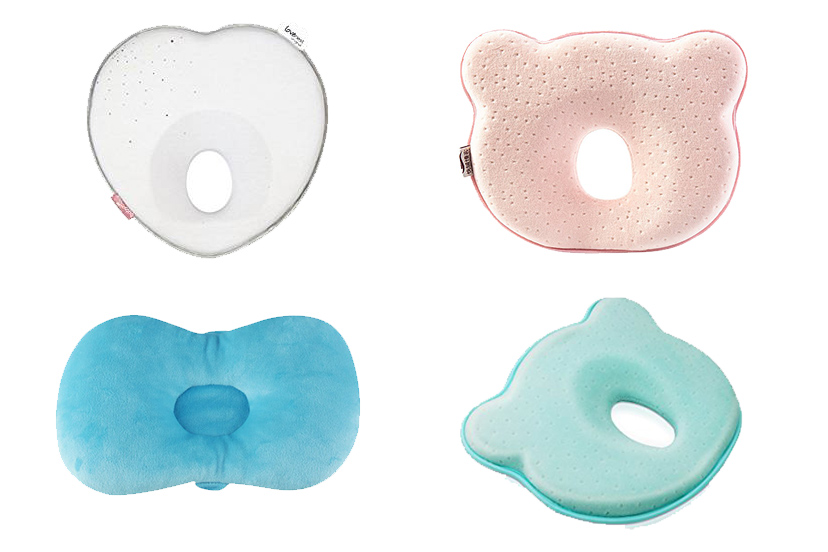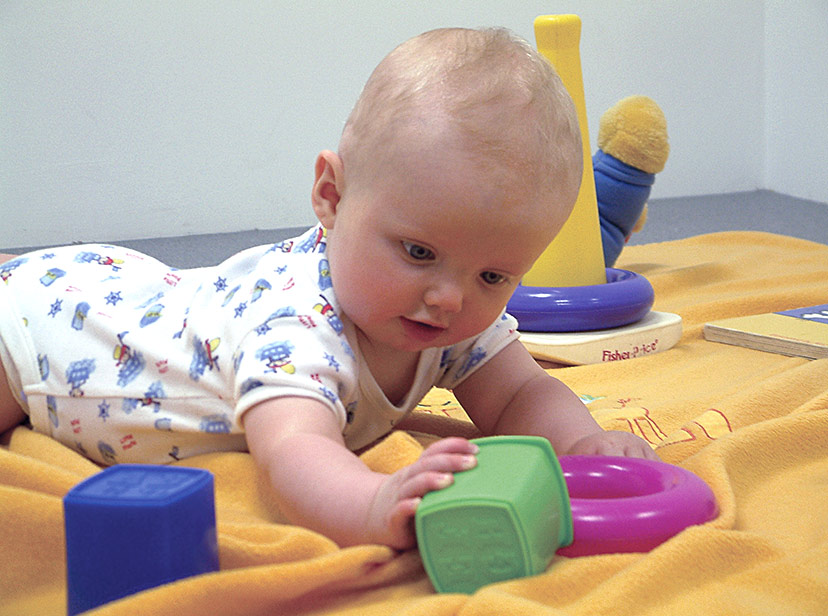
04 April 2018
It’s normal for parents to become anxious if they notice their baby’s head developing flat spots and becoming misshapen. The most common cause is flat head syndrome, or positional plagiocephaly, where a baby’s head changes shape due to pressure applied to the skull (which can be caused by anything from childbirth to their sleeping position or prolonged time spent in car seats) whilst the skull is still malleable.

As a result of this, many companies have been quick to market ‘special’ pillows which are said to prevent the occurrence of flat head syndrome. They can be bought for less than £10.00 online in a variety of shapes, sizes and colours, but do they actually work? And more importantly – are they safe? The answer to both questions is no.
Firstly, it has been well documented that the incidence of flat head syndrome has increased exponentially since the “Back to Sleep” campaign of the 1990s where parents were first encouraged to put their babies to sleep on their backs (supine position) with no toys or blankets in the crib in order to prevent Sudden Infant Death Syndrome (SIDS). The campaign was successful in raising awareness and reduced the number of cot deaths from 1,545 in 1989 to current figures which are roughly 200 a year.
Babies sleeping in the same position means they are more likely to develop flat head syndrome. The guidance remains that babies should be put to sleep on their backs without any objects around, to prevent the risk of cot death. Objects such as pillows should not be used as a baby’s face could potentially be smothered by the object increasing the risk of SIDS.
![A doll lies in an unsafe infant sleeping environment at the Family Health Care clinic at the Joint Base Elmendorf-Richardson hospital, Alaska. Photo by Airman 1st Class Christopher Morales [Public domain], via Wikimedia Commons.](/media/1300/all_about_babies_class_is_back-_baby_151223-f-wt808.jpg)
A doll lies in an unsafe infant sleeping environment at the Family Health Care clinic at the Joint Base Elmendorf-Richardson hospital, Alaska. Photo by Airman 1st Class Christopher Morales [Public domain], via Wikimedia Commons.
The most common form of sleep positioners includes pillows or supports called ‘bolsters’ which often feature a matt with a foam wedge to cushion a baby’s head. Other products called anti-roll mats or nests can cause suffocation. Warnings against using them have been repeatedly echoed by the US Food and Drug Administration (FDA) who issued a fresh warning in 2010 after discovering that these products have a risk of suffocation. In 2010, the FDA explicitly asked manufacturers to stop marketing anti-plagiocephaly products, as no scientific evidence has been found to support medical claims that they prevent or stop flat head syndrome.
UK charities like the Lullaby Trust, which raise awareness about SIDs firmly stick to the line that the use of bed linen, such as quilts, pillows and duvets, is associated with an increased risk of SIDS in the UK*. NHS guidelines specifically advise that in order to reduce the risk of SIDs, your baby’s head should be uncovered and that blankets are tucked in no higher than their shoulders.
At LOC, we do not recommend the use of pillows as a way to prevent flat head syndrome from happening as this would be against all official advice that has served to keep thousands of babies alive since the 1990s. Neither has there been any evidence that suggests these pillows actually prevent flat head syndrome.
So – what should you do as a parent? The most important thing is to follow the advice of the Back to Sleep campaign. That said, no parent wants their child’s head to become misshaped either, so what can you do?
Luckily, there are a few things parents can do to reduce the chance of flat head syndrome occurring. Try to abide by Tummy Time and repositioning advice –where your baby is encouraged to play on their stomach, as this isn’t putting pressure on any part of their head, allowing it to grow normally. This also helps to strengthen their neck and trunk muscles as they progress towards pushing up and crawling.

Above: Tummy Time is a great way to get your baby to naturally use their neck muscles
Another thing to remember is that flat head syndrome is more easily treated the younger a baby is; ideally between the age of four and seven months. That means that if you notice misshaping beginning to occur, bring your child to a clinic such as LOC as soon as possible. The older a baby gets, the less malleable their skull becomes, making correction of the asymmetry more difficult.
At LOC, we treat the condition with our bespoke LOCBand helmets. These are comfortable, bespoke orthoses for babies and are made individually for each child. The LOCBand is produced after taking measurements of a baby’s head and is then fitted. It allows the flatter areas to grow and the more protruding areas are kept from misshaping further so with time, the shape is corrected.
According to a 2015 study published in the Journal of the American Society of Plastic Surgeons, 94.4% of babies who received helmet therapy achieved a complete correction. Typically, the process takes between three and six months and can be carried out, generally with successful results up to the age of 16 months. There have been exceptional cases where a baby’s fontanelles have not fused by the age of 18 months, where we have achieved successful, but less-marked results with cranial remoulding therapy.
Remember, the safest crib is a bare crib, avoid products that profess to reduce the risk of flat head syndrome and always put your little one on their back to sleep.
*The Lullaby Trust: Evidence Base, June 2016.
Main image Copyright: 123RF Stock Photo
This is very much dependent on how fast your baby is growing. The faster the growth, the more frequently your baby will be seen so that the helmet can be adjusted. In general, reviews will happen at two to four-week intervals.
The price of treatment covers:
Yes - All babies that have completed their course of treatment with us have achieved a measurable improvement in head shape. However, you don’t have to take our word for it.
Recent independent research conducted by a University Hospital in Germany has endorsed the treatment for babies with moderate or severe plagiocephaly.
A larger, retrospective study has just been published that found complete correction was achieved in 94.4% of babies treated with helmet therapy.
The results were conclusive: repositioning achieved acceptable correction in 77.1% of cases, but 15.8% were moved onto helmet therapy because re-positioning was not working. Meanwhile, 94.4% of the infants who started in the helmet-treated group achieved full correction, as did 96.1% of those who were transferred from the repositioning group into the helmet-treated group.
Further information can be found on our Plagiocephaly Research page.
If your baby has a temperature or a fever due to illness you must remove the band. The band can be put back on once the temperature has returned to normal.
The optimum age for treatment is between four and seven months.
This is because the skull is most malleable at this age and improvements to head shape tend to take less time and are more dramatic. That is not to say that helmet therapy should be ruled out if the baby is older than seven months. Routinely, babies up to the age of 16 months can be treated very successfully.
The cut off age is around 18 months when the fontanelles (soft spots on the head) are no longer malleable. As babies grow and develop at different rates, it is always worth checking if you are not sure. There have been cases where a baby’s fontanelles have not fused yet by the age of 18 months, who have achieved successful, but less-marked results with cranial remoulding therapy.
Torticollis is a condition in which a tight or shortened muscle in one side of the neck causes the head to tilt or turn to one side, resulting in the infant resting its head in the same position. In 2013, we analysed the data from all first appointments in our Kingston clinic and found that 20% of the babies examined had some kind of neck condition that was causing head immobility.
The clinics and clinicians that provide this treatment in the UK will have received similar training and experience. However, we are the only clinic that manufactures its own helmet and our clinicians are closely involved with the process for each individual helmet that we produce.
In addition, we do not restrict review appointments to a set number, we are extremely flexible and respond to individual parents' needs so that the best outcome can be achieved for each baby.
The LOCband is non-invasive and works by applying gentle, constant pressure over the areas of the baby’s skull that are most prominent while allowing unrestricted growth over the flattened areas. The band consists of a soft foam layer inside a thermoplastic shell. As the baby grows, the band will be adjusted frequently to gently guide the skull into a more symmetrical shape.